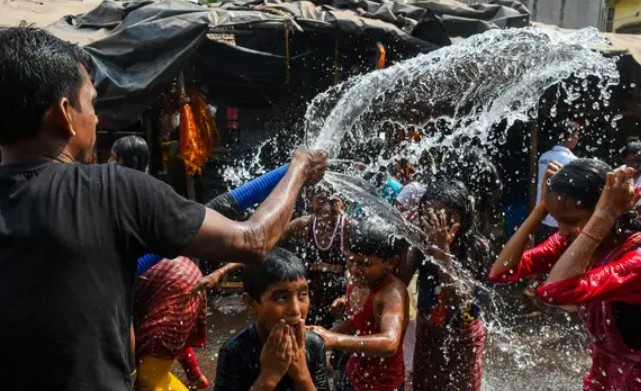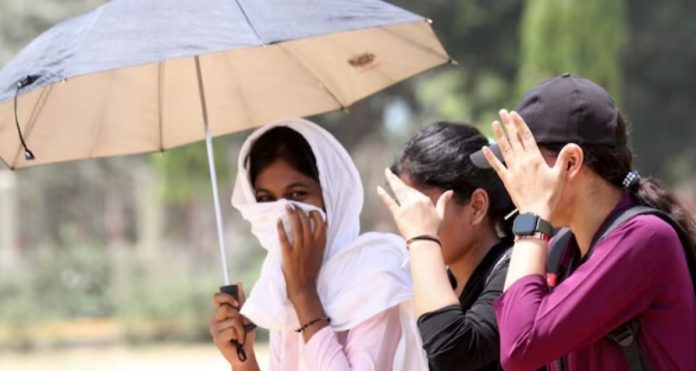Punjab continues to reel under an intense heatwave, with meteorological experts warning that the mercury is likely to climb even further in the coming days. The state, known for its lush fields and agricultural vitality, is currently experiencing one of its harshest spells of pre-monsoon heat in recent years. With the end of April fast approaching, the Indian Meteorological Department (IMD) has issued an alert, forecasting that temperatures could touch or even exceed 45°C in several districts by the month’s end, sparking concerns for public health, agriculture, and water resources.
On Thursday, several towns and cities across Punjab recorded temperatures well above normal for this time of year. Bathinda, Ferozepur, Patiala, and Ludhiana were among the worst-hit, with day temperatures hovering around 43°C. Residents have reported unbearable conditions, with dry, hot winds sweeping across urban and rural areas alike, making daily life difficult and forcing many to remain indoors during peak daylight hours.
Meteorologists attribute this persistent heatwave to a combination of climate anomalies, weak pre-monsoon activity, and delayed western disturbances. According to IMD officials, a high-pressure system over northwestern India is trapping heat and preventing cloud formation, resulting in cloudless skies and searing sunshine. The absence of rain, coupled with low relative humidity, has exacerbated the impact of the heat, contributing to an uptick in cases of heat exhaustion, dehydration, and other heat-related ailments across the state.
Hospitals have started reporting an increase in patients complaining of symptoms ranging from fatigue, dizziness, heat rashes, and in some severe cases, heatstroke. Elderly citizens, children, and individuals with chronic illnesses are particularly vulnerable. Doctors are urging the public to stay hydrated, avoid venturing out during afternoon hours, and wear light cotton clothing to minimize the risk of heat-related complications.
School authorities in multiple districts have already issued revised schedules to help students cope with the extreme conditions. Many schools are starting their sessions earlier in the day and finishing by noon to reduce children’s exposure to the worst of the heat. Meanwhile, the education department has said it is closely monitoring the situation and may consider early summer vacations if the temperatures continue to climb.

For the state’s agrarian economy, the heatwave presents a dual challenge. On one hand, the soaring temperatures are impacting the health and productivity of farmers and agricultural laborers. On the other, the heat stress could adversely affect the yield and quality of certain crops, especially fruits and vegetables that are sensitive to extreme heat. Experts warn that if the current trend continues, there could be serious repercussions for Punjab’s agricultural output this season.
Water scarcity is another concern arising from the relentless heat. As the temperature rises, water levels in reservoirs, rivers, and canals have begun to recede. Many rural areas are already witnessing a drop in groundwater tables, leading to worries about irrigation for upcoming crop cycles and drinking water supplies for both people and livestock. In response, the Punjab government has urged citizens to use water judiciously and is planning to implement emergency measures if the situation worsens.
Local municipal bodies are working overtime to supply water tankers to parched areas and have initiated awareness campaigns to educate the public about heatwave preparedness and safety. Authorities are also setting up temporary shelters equipped with water coolers and shaded seating for daily wage laborers, rickshaw pullers, and others who spend large parts of their day outdoors.
Residents of Punjab are also being advised to modify their diet to combat the oppressive weather. Nutritionists are recommending the inclusion of water-rich fruits like watermelon, muskmelon, cucumber, and lemon water in daily meals, while avoiding spicy and oily foods that can lead to dehydration. Traditional coolants like lassi, chaach (buttermilk), and aam panna are also making a strong comeback in households across the state as people look to age-old remedies to beat the heat.
The situation has also sparked discussions around climate change and its increasingly visible effects on seasonal weather patterns. Experts argue that such extreme temperature spikes, which once used to be rare, are becoming more frequent and intense. They emphasize the urgent need for sustainable urban planning, improved green cover, and adoption of climate-resilient agricultural practices to mitigate the long-term impact of global warming on the region.
Punjab’s power grid is under immense pressure as demand for electricity has surged with the extensive use of air conditioners, coolers, and fans. Power consumption in the state has crossed 2,500 megawatts in some days, according to the Punjab State Power Corporation Limited (PSPCL). The state government has assured uninterrupted power supply during the heatwave but has also appealed to citizens to minimize unnecessary consumption during peak hours.
Looking ahead, IMD officials have warned that there is little hope for respite in the immediate future. While a minor dip in temperatures is possible if isolated thunderstorms develop in the hilly regions of Himachal Pradesh and Jammu & Kashmir and extend southward, any substantial relief is unlikely until the arrival of the southwest monsoon, which is typically expected in mid-to-late June.
As the state navigates this challenging climatic phase, collective awareness and timely action remain crucial. From individuals adopting protective measures in their daily routines to institutional preparedness and government intervention, a concerted approach is necessary to manage the crisis effectively. The people of Punjab, known for their resilience and resourcefulness, are once again bracing themselves to endure the scorching days ahead, hoping for cooler winds and cloudy skies in the weeks to come.
Until then, the advice from health experts and weather authorities remains the same: stay cool, stay hydrated, and take all precautions seriously as Punjab continues to endure the relentless grip of this unyielding heatwave.


